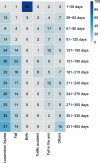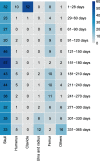Epidemiology of skeletal trauma and skull fractures in children younger than 1 year in Shenzhen: a retrospective study of 664 patients
- PMID: 34174865
- PMCID: PMC8236158
- DOI: 10.1186/s12891-021-04438-8
Epidemiology of skeletal trauma and skull fractures in children younger than 1 year in Shenzhen: a retrospective study of 664 patients
Abstract
Background: Unintentional injury is one of the top three causes of death for infants. However, the epidemiological studies of skeletal trauma and skull fractures in infants younger than 1 year were poorly understood in China. Therefore, our study aimed to examine accidental and emergency attendance in infants under 1 year. It also tried to determine the prevalence and severity of accident types in infants.
Methods: A retrospective analysis was performed on the demographic characteristics of infants younger than 1 year with skeletal trauma and skull fractures who visited the Shenzhen Children's Hospital from January 1, 2016 to December 31, 2019. Age, gender, fracture site and type, mechanism of injury, length of visit, length of hospital stay, hospitalization cost, and treatment methods were analyzed.
Results: A total number of 675 fractures in 664 infants were included, the median age was 187days (IQR,90-273days), including 394 males and 270 females. The top three fracture sites were the skull (430 sites, 63.70 %), long bones of the limbs (168 sites, 24.89 %), and clavicle (53 sites, 7.85 %). The top three causes of injury were locomotion injuries (256 cases, 38.55 %), falls or trips from low height (from beds, tables, chairs, etc.) (130 cases, 19.58 %), and birth injuries (97 cases, 14.61 %). The greatest amount of fractures occurred in children 1-28 days of life (d) reached a top of 101 cases, followed by 331-365 days, accounting for 15.21 and 10.24 %, respectively. The number of fractures reached a trough of 29 cases in the 29-60d group (4.37 %). And increased again to 65 cases in the 151-180d group (9.79 %). The proportion remained relatively constant at 9 % in the 181-210d group (9.19 %) and 211-240d group (9.64 %). The interval between injury and visiting our hospital was ≤ 72 h in 554 cases.
Conclusions: Special attention should be given to the demographic characteristics of fractures in infants under 1 year of age, and appropriate outreach should be implemented. For example, health education should be provided to aid in the prevention especially for frequently occurring locomotion injuries, and prompt access to specialist medical care should be recommended for skull fractures, which are prone to delayed treatment. In addition, multidisciplinary collaboration should be implemented in trauma care, while also promoting the establishment of trauma centers in specialist children's hospitals with a stronger capacity to treat pediatric trauma, and a regional system for pediatric trauma treatment.
Keywords: Epidemiology; fracture; infant; skull fractures.
Conflict of interest statement
For all authors, none was declared.
Figures






Similar articles
-
[Home falls in infants before walking acquisition].Arch Pediatr. 2013 May;20(5):484-91. doi: 10.1016/j.arcped.2013.02.071. Epub 2013 Apr 4. Arch Pediatr. 2013. PMID: 23562734 French.
-
Upper limb pediatric fractures in 22 tertiary children's hospitals, China: a multicenter epidemiological investigation and economic factor analysis of 32,832 hospitalized children.J Orthop Surg Res. 2022 Jun 3;17(1):300. doi: 10.1186/s13018-022-03159-5. J Orthop Surg Res. 2022. PMID: 35658921 Free PMC article.
-
Skull fractures in infants and predictors of associated intracranial injury.Pediatr Emerg Care. 1997 Jun;13(3):198-203. doi: 10.1097/00006565-199706000-00006. Pediatr Emerg Care. 1997. PMID: 9220506
-
Cervical spine injuries in children: a review of 103 patients treated consecutively at a level 1 pediatric trauma center.J Pediatr Surg. 2001 Aug;36(8):1107-14. doi: 10.1053/jpsu.2001.25665. J Pediatr Surg. 2001. PMID: 11479837 Review.
-
Pediatric basilar skull fractures from multi-level falls: A systematic review and retrospective analysis.Int J Pediatr Otorhinolaryngol. 2022 Nov;162:111291. doi: 10.1016/j.ijporl.2022.111291. Epub 2022 Aug 22. Int J Pediatr Otorhinolaryngol. 2022. PMID: 36030630
Cited by
-
Computed Tomography Findings of Children Under 3 Years of Age with Mild Traumatic Brain Injury (TBI) and No Neurological Focal Signs.J Clin Med. 2025 Apr 16;14(8):2728. doi: 10.3390/jcm14082728. J Clin Med. 2025. PMID: 40283558 Free PMC article.
References
MeSH terms
Grants and funding
- SZSM202011012/Sanming Project of Medicine in Shenzhen
- SZSM202011012/Sanming Project of Medicine in Shenzhen
- SZSM202011012/Sanming Project of Medicine in Shenzhen
- SZSM202011012/Sanming Project of Medicine in Shenzhen
- SZSM202011012/Sanming Project of Medicine in Shenzhen
- SZSM202011012/Sanming Project of Medicine in Shenzhen
- SZSM202011012/Sanming Project of Medicine in Shenzhen
- SZSM202011012/Sanming Project of Medicine in Shenzhen
- SZSM202011012/Sanming Project of Medicine in Shenzhen
- SZSM202011012/Sanming Project of Medicine in Shenzhen
- SZSM202011012/Sanming Project of Medicine in Shenzhen
- No.SZXK035/Shenzhen Fund for Guangdong Provincial High-level Clinical Key specialties
- No.SZXK035/Shenzhen Fund for Guangdong Provincial High-level Clinical Key specialties
- No.SZXK035/Shenzhen Fund for Guangdong Provincial High-level Clinical Key specialties
- No.SZXK035/Shenzhen Fund for Guangdong Provincial High-level Clinical Key specialties
- No.SZXK035/Shenzhen Fund for Guangdong Provincial High-level Clinical Key specialties
- No.SZXK035/Shenzhen Fund for Guangdong Provincial High-level Clinical Key specialties
- No.SZXK035/Shenzhen Fund for Guangdong Provincial High-level Clinical Key specialties
- No.SZXK035/Shenzhen Fund for Guangdong Provincial High-level Clinical Key specialties
- No.SZXK035/Shenzhen Fund for Guangdong Provincial High-level Clinical Key specialties
- No.SZXK035/Shenzhen Fund for Guangdong Provincial High-level Clinical Key specialties
- No.SZXK035/Shenzhen Fund for Guangdong Provincial High-level Clinical Key specialties
- JCYJ20180228175358223/Shenzhen Innovation Science and Technology Committee
- JCYJ20180228175358223/Shenzhen Innovation Science and Technology Committee
- JCYJ20180228175358223/Shenzhen Innovation Science and Technology Committee
- JCYJ20180228175358223/Shenzhen Innovation Science and Technology Committee
- JCYJ20180228175358223/Shenzhen Innovation Science and Technology Committee
- JCYJ20180228175358223/Shenzhen Innovation Science and Technology Committee
- JCYJ20180228175358223/Shenzhen Innovation Science and Technology Committee
- JCYJ20180228175358223/Shenzhen Innovation Science and Technology Committee
- JCYJ20180228175358223/Shenzhen Innovation Science and Technology Committee
- JCYJ20180228175358223/Shenzhen Innovation Science and Technology Committee
- JCYJ20180228175358223/Shenzhen Innovation Science and Technology Committee
LinkOut - more resources
Full Text Sources
Medical

